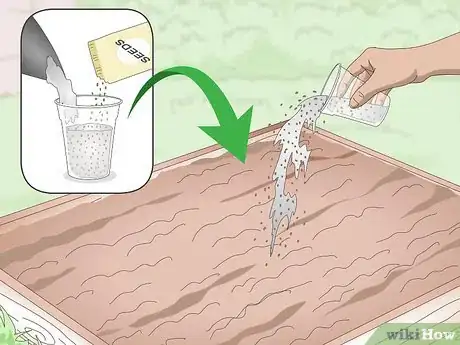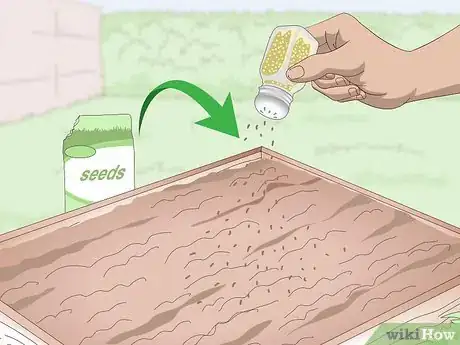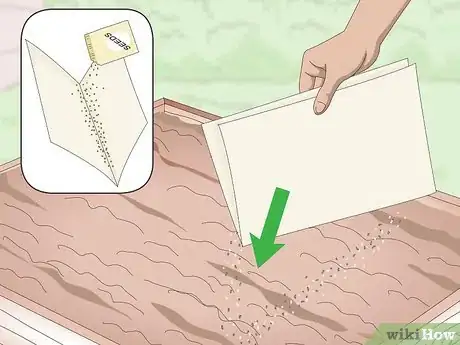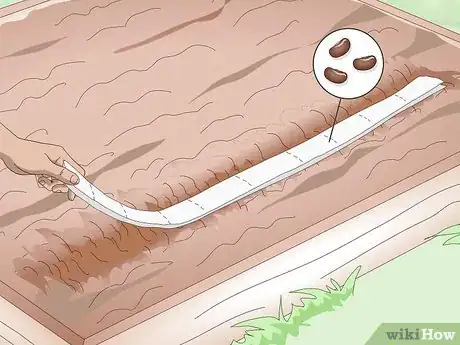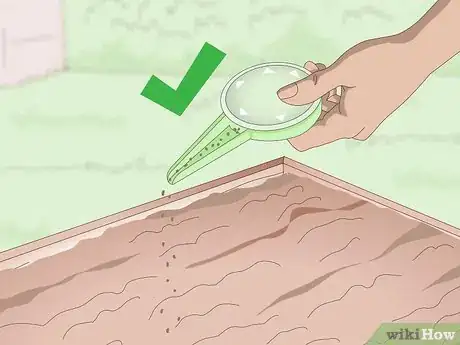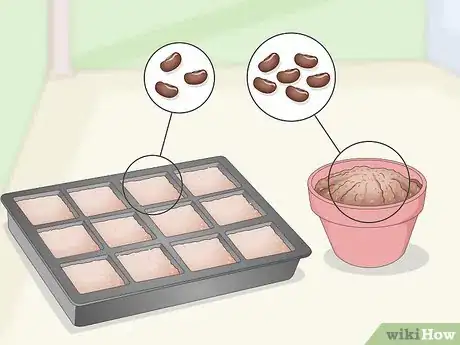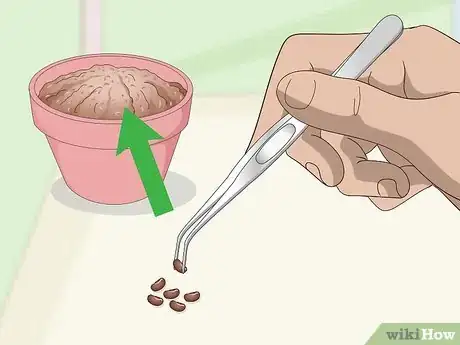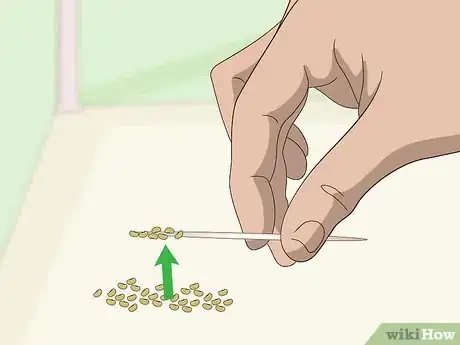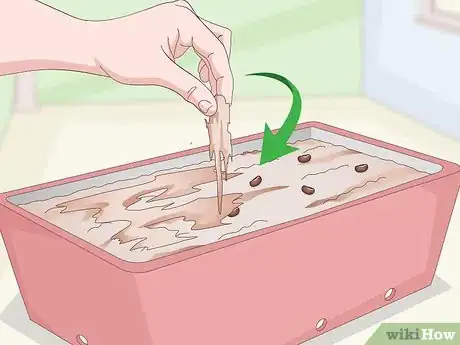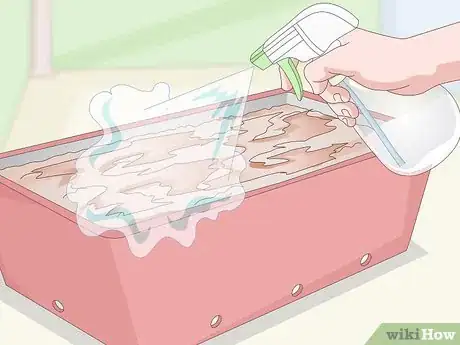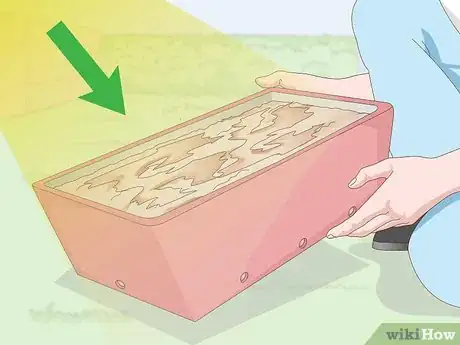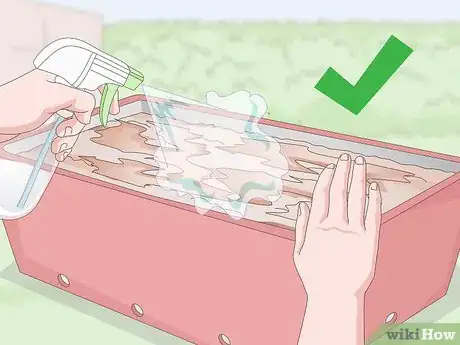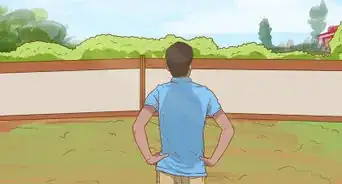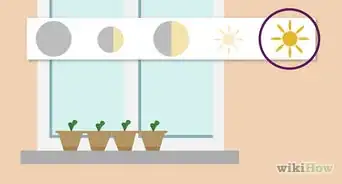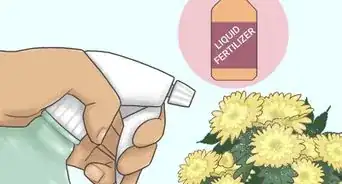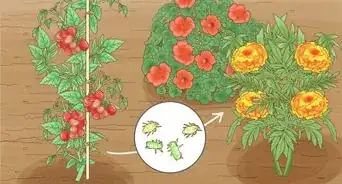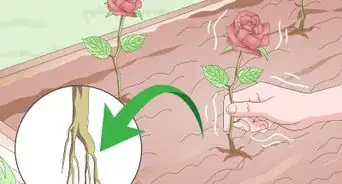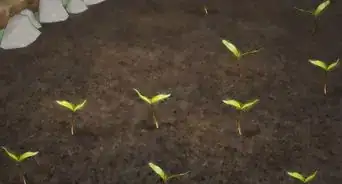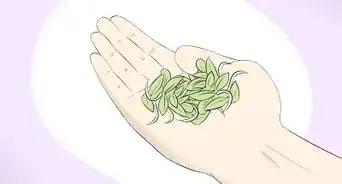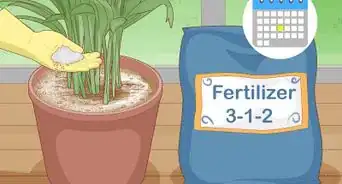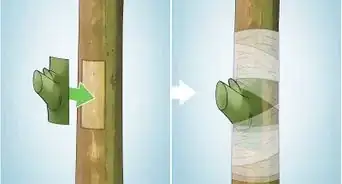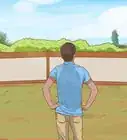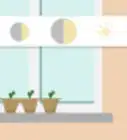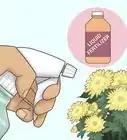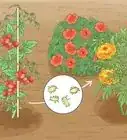This article was co-authored by Lauren Kurtz. Lauren Kurtz is a Naturalist and Horticultural Specialist. Lauren has worked for Aurora, Colorado managing the Water-Wise Garden at Aurora Municipal Center for the Water Conservation Department. She earned a BA in Environmental and Sustainability Studies from Western Michigan University in 2014.
This article has been viewed 68,256 times.
Tiny seeds are often difficult to handle and very hard to see in the soil. To make the sowing process easier, there are several strategies for spreading tiny seeds evenly. Try using a salt shaker, purchasing a sowing tool, or creating seed tape to ensure your seeds are properly spaced. Once the seeds are in position, all they need is a light covering of additional soil, a misting to keep them moist, and some sunlight.
Steps
Distributing Tiny Seeds in the Garden
-
1Mix tiny seeds with fine sand before spreading them in the soil. Fill a cup with a small handful of dry, fine sand. Pour the seeds into the cup as well and mix the seeds and the sand together. When you go to pour the seeds into the soil, the sand mixture will help spread the seeds evenly.[1]
- Pour however many seeds you wish to plant into the sand.
- Plow the soil a bit before sprinkling the sand mixture.
-
2Use a salt shaker to spread seeds evenly. Fill an empty salt shaker with the seeds you wish to plant. Make sure the lid is tightly secured before sprinkling the seeds into the soil from the shaker.[2]
- If you’re sowing the seeds directly into the ground, create a shallow furrow in the soil with your finger and sprinkle the seeds from the salt shaker in a line in the indentation. Read the seed packet to see how deep the seeds need to be sown.
- If you’re planting the seeds in a pot or tiny planter, simply shake the salt shaker 2 or 3 times to release the seeds.
Advertisement -
3Pour seeds into the crease of a folder to sow seeds easily. Use an envelope or empty folder to pour the seeds into. Tap the folder lightly so that the seeds collect in the crease, creating a line of seeds. Tilt the folder to the side so that the seeds fall from the crease in an even line into the soil.[3]
- Create a small furrow in the soil before sprinkling the seeds to help them stay in place.
-
4Create seed tape out of toilet paper for easy seed placement. Rip off a strip of toilet paper the length you’d like to plant your seeds, and use a spray bottle to dampen it. Spread the seeds evenly along the strip of toilet paper before folding the toilet paper in half lengthwise. Place the strip of toilet paper in a shallow trench in the soil.[4]
- You can also place a strip of toilet paper in a shallow trench in the soil first, and then sprinkle the seeds along the toilet paper. The whiteness of the toilet paper will allow you to better see the seeds as you spread them evenly.
- The seed tape will be covered lightly with soil, not just left bare.
- The trench can be anywhere from 0.5–1 inch (1.3–2.5 cm) deep, depending on the type of seeds you are trying to grow.
-
5Purchase a gardening tool designed specifically for sowing seeds. Tools like handheld seed sowers allow you to control how many seeds are released at once so that you can spread them evenly. There are several other types of seed dispensers which can be found at gardening stores or online.[5]
- Fill a handheld seed sower with seeds, and then twist the top to change how many seeds are released through the funnel.
- You can also choose a tiny seedmaster — once these are filled, you can pop out seeds like you would if using a syringe.
- Other options are dibbers and widgers, which assist in the planting. Dibbers have the ability to create deep holes, and widgers work like very skinny spades, great for transplanting plants.
Sowing Tiny Seeds in Pots
-
1Space seeds appropriately for their specific container. If you're using a germination tray, try planting 2-3 seeds per cell. For a small flower pot, you can plant 4-6 seeds in the soil.
- However many seeds you plant, make sure the roots will all have enough room of their own to grow. Research your specific plant type to see how big their roots get.
- Once the seeds sprout, thin them to maintain the proper spacing. Use scissors or pruning shears to cut away any weak or small seedlings. Leave the larger seedlings to grow.
-
2Pick up the seeds using tweezers for precise placement. If you already have a pair of tweezers, use them to pick up a tiny seed and place it into the soil. This will give you precise control over exactly where you plant the seeds.
- Make sure you don't crush the seed between the tweezer's prongs.
-
3Wet a toothpick to pick up tiny seeds easily. Dip a rounded toothpick into some water so that it's damp but not dripping. Place the tip of the toothpick onto a seed so that the seed attaches to the toothpick, and place the seed into the soil using the toothpick as a guide.[6]
-
4Use your fingers to place the seeds carefully in the soil. If you’re planting seeds in a pot or sectioned planter, it can be easiest to simply pour the seeds out in your palm or onto a plate before using your fingers to disperse the seeds. Sprinkle 2-3 seeds per section.[7]
- If you press down on a tiny seed with a finger, the seed should stick to your finger and allow you to transfer the seed easily into the soil.
Covering and Watering the Seeds
-
1Cover the seeds lightly with soil or vermiculite. Small seeds shouldn’t be covered in a deep layer of soil or they’ll have trouble growing. Spread a light, even layer of soil or vermiculite over the seeds, giving them just enough protection from the wind and other elements.[8]
- Sprinkle the soil over the seeds like you might sprinkle seasoning over a food dish.
-
2Water the seeds using a fine mist. If possible, fill a spray bottle with water and lightly mist the soil. Pouring a stream of water into the soil will cause the tiny seeds to move around, so try to use as gentle of a water source as possible.[9]
- The soil should be damp but not completely saturated.
- If you don't have a spray bottle, fill a cup with water and then dip your fingers into it. Sprinkle the water over the seeds using your fingers.
- If it's expected to rain heavily, you could use something such as a row cover to help protect the seeds.
-
3Place the planter in a sunny spot, if applicable. If you’ve planted your seeds in a pot or planter, place the planter in a sunny spot like on a window sill. The seeds will need access to direct sunlight to begin growing.[10]
- If you’ve planted the seeds outside, make sure you placed them in an area that receives sunlight.
- While it can vary between plants, most seedlings germinate at a temperature of 65 °F (18 °C) or higher.
- You can cover the planter with a propagator lid to keep in moisture if you’d like.
-
4Ensure the soil doesn’t dry out. Keep an eye on the soil, touching it with your fingers to make sure it’s still damp. If the soil feels dry to you, use a spray bottle to apply a light mist to the soil.[11]
- Check on your seeds every day or 2 after you first plant them to ensure they’re getting the proper hydration and sunlight.
Community Q&A
Did you know you can get answers researched by wikiHow Staff?
Unlock staff-researched answers by supporting wikiHow
-
QuestionWhen can I prick out the seedlings?
 wikiHow Staff EditorThis answer was written by one of our trained team of researchers who validated it for accuracy and comprehensiveness.
wikiHow Staff EditorThis answer was written by one of our trained team of researchers who validated it for accuracy and comprehensiveness.
Staff Answer wikiHow Staff EditorStaff AnswerThe seedlings need to have at least two pairs of leaves or be strong enough to be plucked before they are ready for pricking out or thinning. Don't wait too long though, as you don't want to risk damaging the roots of the seedlings left to grow. Choose seedlings that look weak, are broken or limp or that are otherwise imperfect. This will allow the stronger plants to thrive.
wikiHow Staff EditorStaff AnswerThe seedlings need to have at least two pairs of leaves or be strong enough to be plucked before they are ready for pricking out or thinning. Don't wait too long though, as you don't want to risk damaging the roots of the seedlings left to grow. Choose seedlings that look weak, are broken or limp or that are otherwise imperfect. This will allow the stronger plants to thrive. -
QuestionWhere should I keep the seed tray once planted?
 wikiHow Staff EditorThis answer was written by one of our trained team of researchers who validated it for accuracy and comprehensiveness.
wikiHow Staff EditorThis answer was written by one of our trained team of researchers who validated it for accuracy and comprehensiveness.
Staff Answer wikiHow Staff EditorStaff AnswerTry to the seed tray somewhere warm, such as in front of a window with direct sunlight, in a cold frame or even near your central heating boiler initially (but move it once the seeds germinate, as they will need direct sunlight). Some people use airing cupboards when the seeds are first planted, then move the seeds to a sunny area once sprouted. You can also purchase a propagator and place it somewhere warm, then move to the sunny space once the seeds germinate.
wikiHow Staff EditorStaff AnswerTry to the seed tray somewhere warm, such as in front of a window with direct sunlight, in a cold frame or even near your central heating boiler initially (but move it once the seeds germinate, as they will need direct sunlight). Some people use airing cupboards when the seeds are first planted, then move the seeds to a sunny area once sprouted. You can also purchase a propagator and place it somewhere warm, then move to the sunny space once the seeds germinate. -
QuestionWhat causes seedlings to damp off?
 wikiHow Staff EditorThis answer was written by one of our trained team of researchers who validated it for accuracy and comprehensiveness.
wikiHow Staff EditorThis answer was written by one of our trained team of researchers who validated it for accuracy and comprehensiveness.
Staff Answer wikiHow Staff EditorStaff AnswerThe usual culprit when seedlings dampen off is too moist an environment, allowing for algal or bacterial growth. This can happen when the seedlings are inside a propagator or cold frame and the moisture is not removed. To avoid this, regularly wipe down any moisture that has formed on the sides and lids of any container you're keeping the seedlings warm in.
wikiHow Staff EditorStaff AnswerThe usual culprit when seedlings dampen off is too moist an environment, allowing for algal or bacterial growth. This can happen when the seedlings are inside a propagator or cold frame and the moisture is not removed. To avoid this, regularly wipe down any moisture that has formed on the sides and lids of any container you're keeping the seedlings warm in.
References
- ↑ https://www.growveg.com/guides/5-gardening-hacks-for-seed-sowing-success/
- ↑ https://www.youtube.com/watch?v=S9ZmyqmgSB4
- ↑ https://www.youtube.com/watch?v=S9ZmyqmgSB4
- ↑ https://www.rodalesorganiclife.com/garden/plant-tiny-seeds-making-seed-tape
- ↑ https://www.youtube.com/watch?v=S9ZmyqmgSB4
- ↑ https://empressofdirt.net/tips-sowing-tiny-seeds/
- ↑ http://www.gardenersworld.com/how-to/grow-plants/sowing-small-seeds/
- ↑ http://www.gardenersworld.com/how-to/grow-plants/sowing-small-seeds/
- ↑ http://www.gardenersworld.com/how-to/grow-plants/sowing-small-seeds/
